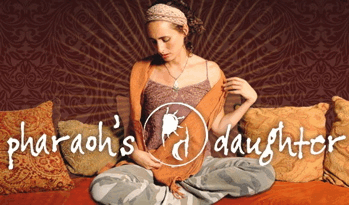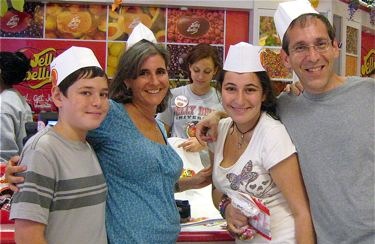 “Lunch was very nice, but I was hoping we could sing a few zemirot,†commented one of our guests this past Shabbat. He didn’t mean it in a critical way; he was just expressing his hope that would sing a bit around the table before tidying up the dessert and heading for a Shabbat afternoon nap.
“Lunch was very nice, but I was hoping we could sing a few zemirot,†commented one of our guests this past Shabbat. He didn’t mean it in a critical way; he was just expressing his hope that would sing a bit around the table before tidying up the dessert and heading for a Shabbat afternoon nap.
The thing is, I’ve been down on zemirot for a while now. That’s is a real change from how our family used to be. When Jody and I were studying in Israel in the mid-1980s, singing songs around the Shabbat table was an integral part of our communal experience. We learned zemirot from our teachers at Pardes, we introduced new tunes to our friends, we even took to occasionally penning a melody ourselves.
But after years of the same tunes, I got tired of our repertoire. All the traditional songs had become intolerable dirges or sounded like British marching ditties. “Yom ze meCHUbad, mikol YAmim ki vo SHAbat TZUR olaMIM (toot toot)†we’d belt out, swinging our arms like we were in an Irish pub carousing after a football match.
When we started going to a Shlomo Carlebach minyan several years ago, we tried applying some of the melodies we heard there to the words of the zemirot, but it never quite fit right. My friend Eliezer succeeded in updating some of Birkat HaMazon, the grace after meals, but that’s about as far as it went. We hummed a few wordless nigunim with the incumbent lalas and yayas, but it wasn’t the same.
We always have a great time at the Shabbat table. Lots of yummy food, good conversation and laughs. But zemirot had dropped off the radar.
That was until Saturday night when we went to hear the New York ethno-Hassidic world beat rock band Pharaoh’s Daughter making its first appearance in Jerusalem. Led by the charismatic Brooklyn-born Basya Schechter, the seven-piece band, which is among the darlings of the new Jewish music scene in New York, is hard to categorize. With Schechter on lead vocals, oud and guitar, and featuring Daphna Mor on back up vocals and woodwinds, Pharaoh’s Daughter performs in four languages – Hebrew, Arabic, Ladino and Yiddish and have a play list that ranges from neo-Klezmer to Egyptian-tinged Middle Eastern rhythms.
National Geographic described the band on its World Music Podcast as fusing “Middle Eastern and Jewish sounds with a dark, indie pop sensibility, making music that has traditional roots, and a hip, modern edge.”
NewYorkCool.com referred to the band this way: “Have you ever wondered what would happen if Pink Floyd and PJ Harvey crossed paths in a cafe in Israel and subsequently took a road trip to South Africa? What if they met up with Radiohead in Morocco along the way?â€
Pharaoh’s Daughter’s sold out Motzei Shabbat show was held in Jerusalem’s Beit Avichai’s new auditorium which sports some of the best acoustics I’ve heard at any concert here or abroad. The audience was a classic Jerusalem mix of religious and secular, young and old, proving the band has legs that extend beyond the trendy twentysomething Jewcy and Heeb scene in New York.
But the highlight of the show for me was Pharaoh’s Daughter’s re-conceptualization of the traditional zemirot. I’d be hard pressed to repeat them at the Shabbat table – the instrumentation and harmonies were too complex for the average Shabbat meal – but it was a treat to hear how far a field a multi-talented musician like Shechter can take the classic lyrics of these Talmudic and Kabbalistic songs. From the lilting guitars of the show opener Lev Tahor through an audience participation sing along version of Yona Matzah and into the closing number HaShomer, Pharaoh’s Daughter returned a sense of swirling spirituality that has gotten lost in our own Shabbats.
Pharaoh’s Daughter is about much more than new fangled zemirot of course. A highlight of the show was a guitar duet between Schechter and Avi Fox-Rosen setting the early Yiddish poetry of Jewish philosopher A.J. Heschel to music. Another high point was a “performance art piece,†as Schechter called it, recreating a traditional Yeshiva “taitch†(from the band’s 2000 release “Out of the Reedsâ€) where Hebrew is translated into Yiddish in a chanting sing-song. It helps that Shechter grew up speaking Yiddish as well as English.
Pharaoh’s Daughter’s fourth CD is Haran and is available here on Amazon.com. The band, described on its own website as “blending a psychedelic sensibility and a pan-Mediterranean sensuality with Doors-like improvisations, liturgical chants with Middle Eastern, and spiritual stylings†has toured the Middle East, Africa, Israel, Egypt, Turkey, Kurdistan and Greece. Pharaoh’s Daughter has played the Queen Elizabeth Hall in London and debuted at New York Central Park’s Summer Stage series in 2004.
Schechter grew up in the ultra-Orthodox neighborhood of New York’s Boro Park and, in an interview on PRI’s “The World” radio program, explains that until the age of 15 she went to all girls schools and was only exposed to boys and music when she participated in a teen trip to Israel where she “had a boyfriend who played me Led Zeppelin and introduced me to all this music I had never heard before. I would learn the melodies note by note,†Schechter says.
Schechter later left New York and her religious community to hitchhike around Turkey and Africa. She learned to play the oud in Morocco and the saz in Turkey. Today, she and Pharaoh’s Daughter flautist Daphna Mor both play in the musical ensemble that accompanies Friday night services at Manhattan’s conservative B’nei Jeshrun synagogue.
The band’s performance in Jerusalem was a delight – pushing the boundaries of Jewish music while inspiring our Shabbat table beyond the dirges of yesteryear. Go for the music, go for inspiration on new age zemirot, just go. Don’t miss Pharaoh’s Daughter if they come to a town near you.

